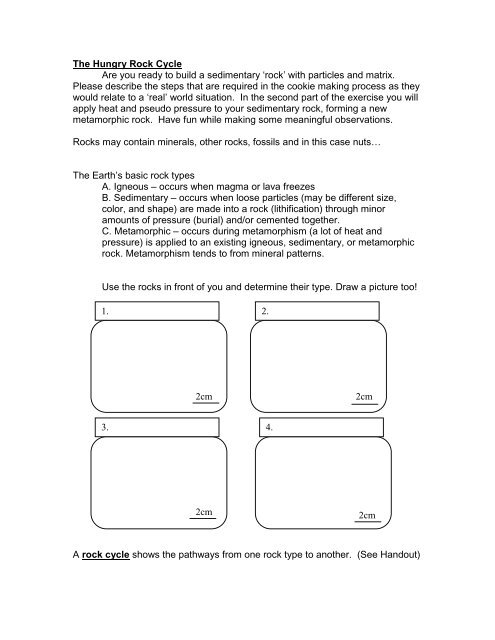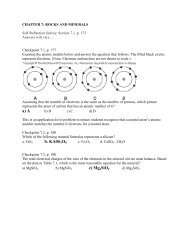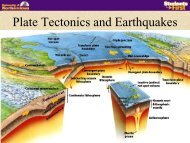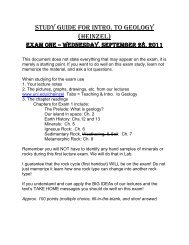Rock cycle Cookie Exercise
Rock cycle Cookie Exercise
Rock cycle Cookie Exercise
You also want an ePaper? Increase the reach of your titles
YUMPU automatically turns print PDFs into web optimized ePapers that Google loves.
The Hungry <strong>Rock</strong> Cycle<br />
Are you ready to build a sedimentary ‘rock’ with particles and matrix.<br />
Please describe the steps that are required in the cookie making process as they<br />
would relate to a ‘real’ world situation. In the second part of the exercise you will<br />
apply heat and pseudo pressure to your sedimentary rock, forming a new<br />
metamorphic rock. Have fun while making some meaningful observations.<br />
<strong>Rock</strong>s may contain minerals, other rocks, fossils and in this case nuts…<br />
The Earth’s basic rock types<br />
A. Igneous – occurs when magma or lava freezes<br />
B. Sedimentary – occurs when loose particles (may be different size,<br />
color, and shape) are made into a rock (lithification) through minor<br />
amounts of pressure (burial) and/or cemented together.<br />
C. Metamorphic – occurs during metamorphism (a lot of heat and<br />
pressure) is applied to an existing igneous, sedimentary, or metamorphic<br />
rock. Metamorphism tends to from mineral patterns.<br />
Use the rocks in front of you and determine their type. Draw a picture too!<br />
1. 2.<br />
2cm<br />
2cm<br />
3. 4.<br />
2cm<br />
2cm<br />
A rock <strong>cycle</strong> shows the pathways from one rock type to another. (See Handout)
a. Take a spoonful of matrix and choose an assortment of particles<br />
that have recently weathered out of an igneous rock to add to you<br />
mix of sediment.<br />
b. Using pressure from your hands to represent burial and compaction<br />
briefly describe what is happening with respect to the matrix and<br />
particles.<br />
Draw a picture<br />
2cm<br />
c. Record the weight of your new sedimentary rock. _________grams<br />
2. List two methods that are capable of changing an existing sedimentary<br />
rock into a metamorphic rock.<br />
a.<br />
b.<br />
3. Take your sedimentary rock and use your geological connections to<br />
change it into a metamorphic rock. Make two testable hypotheses;<br />
a. Hypothesis 1, what do you believe will happen to the weight of your<br />
rock sample with respect to heat and pressure<br />
b. Hypothesis 2, what will happen to the physical characteristics of the<br />
sedimentary rock with respect to heat and pressure
4. The new metamorphic rock<br />
a. What is the weight of your metamorphic rock __________grams<br />
b. Describe your new metamorphic rock, how does it differ from the<br />
previous sedimentary rock Draw a picture…<br />
2cm<br />
Did all particles react to heat and pressure the same way<br />
Explain…<br />
5. How do your observations compare with your hypotheses<br />
Hypothesis 1<br />
Hypothesis 2<br />
Final questions or thoughts….
You’ll need<br />
<strong>Cookie</strong> dough<br />
<strong>Cookie</strong> additions (M&Ms, chocolate chips, some type of nut, etc.) The activity<br />
works best when the cookies additions have different melting temperatures (just<br />
like minerals in the real world)<br />
(oven pans, gloves, spatula, wax paper)<br />
An oven<br />
A scale








